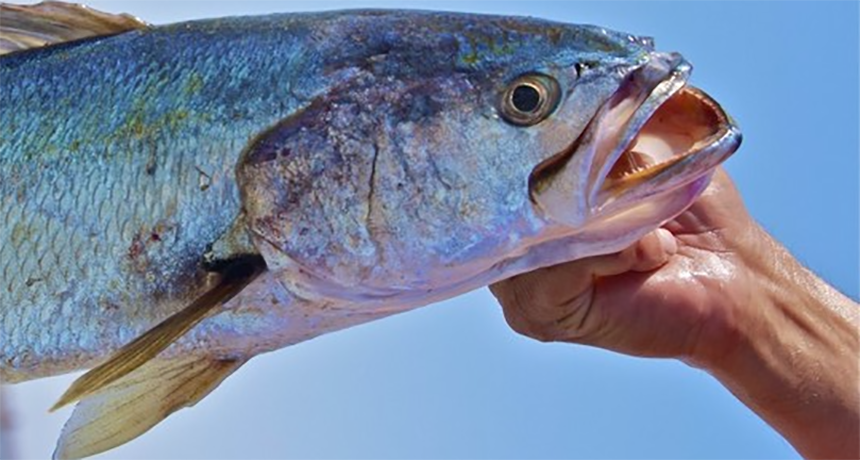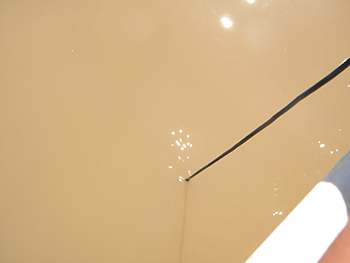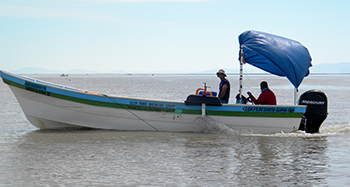Listening to fish love songs can predict their numbers
Scientists use sound to count some of the fish in the sea

This is a fresh-caught Gulf corvina. Scientists have listened in on its mating sounds to determine how many of these fish are around — and if they need protecting.
Gulf of California Marine Program
Life beneath the ocean waves isn’t quiet. In fact, some sea sites can be downright noisy. When one fish species gathers to mate, the machine-gun-like sound of its mating “song” can get so loud it actually can be heard above the waves. Scientists now report being able to estimate how many of these fish are around just by recording their fishy love songs. This technique might help scientists better count some fish and determine whether their communities need protecting.
Fish “calling” is similar to the way many birds use sound to attract mates and ward off predators, notes Timothy Rowell. Once he learned that fish made noise, he wanted to study it. Rowell is a graduate student studying marine biology at the Scripps Institution of Oceanography at the University of California, San Diego.
If fish make noise, Rowell reasoned, it might be possible to estimate how many are out there. To test that, he and his colleagues studied the Gulf corvina (Cynoscion othonopterus). This Gulf of California species is a popular food in Mexico during Lent (the weeks leading up to Easter).
These fish gather in huge groups of more than a million fish to spawn. They do this where the Colorado River meets the Gulf of California. Such huge groups make it easy for fishermen to find them. And that could put the species at risk of being overfished. Already the species is considered vulnerable to extinction. That means it could become endangered if the amounts hauled in by fishermen is not carefully managed.
Getting fishy with it
The river delta where the corvina conduct their affairs isn’t the most romantic venue. The shallow, muddy water “is like chocolate milk,” Rowell explains. “It’s impossible to see what’s going on.” The corvina can’t see their potential mates either. Then again, they may not need to. They can just listen for them.

Corvinas are in a family of fish called the croakers. They make noise by drumming their stomach muscles along their swim bladders (gas-filled organs that help the fish float). An amorous male corvina produces a pulsing rat-tat-tat. Rowell likens it to what “you’d expect a machine gun to sound like.”
Corvinas swim to the delta in spring. There they gather for a few days at the new and full moons. The males tap away, calling females to come mate. “I’d heard it was the loudest spawning in the world,” Rowell says. “It’s a lot louder than any other fish we’d looked at.” When millions of fish gather in some river delta, “the environment acts like a stadium.” The fish get so loud it would be dangerous for a human to be snorkeling, Rowell warns: “It’s as loud as a lawnmower or chainsaw underwater.”
This roar doesn’t go unnoticed above the waves. If you’re in a boat, Rowell says, “it’s like the background rumbling of a busy restaurant.” Fishermen know where to catch the most fish just by listening for them, he points out. Rowell and his colleagues thought that maybe scientists could do the same.
Over four days in the spring of 2014, the scientists went to the delta and lowered hydrophones — microphones that work underwater — into the mass of spawning fish. They recorded fish sounds in different areas of the delta.
The scientists compared the sounds to sonar measurements of the fish population that they took at the same time. Sonar issues sound pulses underwater and measures how long the echoes take to return. When the pulse hits lots of moving, fish-shaped objects, the sound comes back faster. That means there are crowds of fish present.
By combining the sound and sonar, the scientists found a positive correlation — a link between the two. When mating calls were loud, more fish were present. Rowell and his colleagues presented their findings June 13 in Scientific Reports.
“It is a great start towards understanding the relationship between sound production in fishes and estimating the number of fish and where they are,” says Jenni Stanley. This can be very difficult, she points out. Stanley is a marine scientist who specializes in sound. She works at the National Oceanic and Atmospheric Administration’s Northeast Fisheries Science Center in Woods Hole, Mass.
More than fishy flirting
The corvina isn’t alone in liking it loud. “More than 800 species of fish can produce sound and will use sound in everyday behavior,” explains Stanley. They might call out to defend their territory, find mates, feed or just generally chat. “With further research,” she says, the new data might “be applied to other fish species.” But that would work only if they not only produce sound but also congregate in large groups to breed, she says. This might work for Atlantic cod, pollock and grouper, for instance.
Knowing just how many fish are in the sea is important for regulators. Catch too many, and the population of a species might crash to the point it’s in danger of extinction. But if fisherman aren’t allowed to catch enough, they might soon be out of a job. “Fisherman want to keep fishing,” Rowell notes. “They’re really invested in finding a sustainable level.”

Often, governments impose quotas — or specific limits — on fish that can be caught in a given period of time. But to be useful, those numbers must be based on the true number of fish present. To get those numbers, scientists sometimes catch a bunch of fish, tag them and then see how many they recapture.
If they recapture many fish, but very few fish have tags, this could signal that the fish population is large and healthy. Scientists also can use sonar to estimate numbers. Finally, fishing quotas — limits on how many can be caught — can be set based on how large and healthy the species’ population appeared to be the previous year. If the fishermen hadn’t caught all they had wanted to, that might indicate a population was diminishing.
All of these methods, however, have limitations. Catching and tagging fish takes a lot of time. Sonar can be expensive. And basing a quota on the fish caught before doesn’t always work with species like the corvina that gathers in huge groups to spawn. The fish crowd into densely packed groups, whether there are millions of them, or just thousands. If harvests target those crowds, fisherman might catch all they want — even as a population was starting to go down. People might then miss when conditions were starting to become dire.
But if fishermen (and scientists) can listen in on fishy flirting, they may have an inexpensive way to determine how many individuals are around. And with more accurate numbers, fishermen can avoid overharvesting. That should leave more fish to get lucky in love — and produce more fish for years to come.







